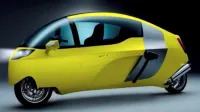In Depth: Monotracer E

That efficiency means the Monotracer E may not suffer from the range issues of larger electric powered vehicles – using less electricity means traveling farther on a single charge. Low energy consumption also means the Monotracer E can run on battery power alone and the aerodynamic shape helps it achieve high speeds without losing range. All electric cars spend a good portion of their energy simply pushing air out of the way; the slipperier the vehicle the less energy is has to spend on fighting the air it’s moving through. Because of this, the Monotracer E has a range of about 150 miles, even if it’s driven at highway speed.
The E accomplishes all this and still has seating for two. Because the passenger sits behind the driver, the Monotracer has a very low drag coefficient of just .19 – by comparison, a Toyota Prius has a drag coefficient of .25 and most modern sedans are between .30 and .35 while trucks and SUVs are higher. The lower the number, the better the vehicle slips through the air.
Aiding the overall efficiency of both the gas powered Monotracer and the electric Monotracer E is a relatively low weight. Depending on which options a buyer chooses, the Monotracer’s dry weight is between 1,014 and 1,069 pounds – about a third of a traditional passenger vehicle. The low weight is achieved by using strong, lightweight materials to build the body. The outer shell is made from Kevlar and a carbon, fiberglass tissue, while the safety cage is aluminum. The engine frame, steering mechanism and stabilizer axles are made from aircraft grade alloy steel. Opt for the gas powered Monotracer and you’ll get about 55 miles per gallon.
But the Monotracer isn’t without its comforts. There’s a heating and ventilation system, and air-conditioning is optional. A CD audio system with GPS and RDS for the radio is available, along with cruise control and Bi-Xenon headlights.
Want to buy one? You can, but it’s not cheap – the price is roughly $65,000. There’s a gas powered version or the EV featured here on Translogic. For more information on purchasing a Monotracer check out 21st Century Motoring’s site.




